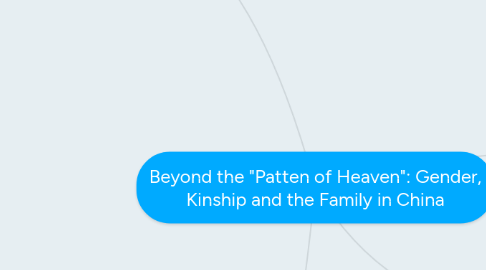
1. THE HAN CHINESE
1.1. Confucianism
1.1.1. Founded by Kong Fuzi
1.1.2. Open system that allows anyone to join
1.1.2.1. typically men
1.1.3. Filial Peity
1.1.3.1. "the pattern of Heaven"
1.1.4. Focus on men
1.1.4.1. to become junzi (gentlemen)
1.1.4.2. role of women is to help men become junzi
1.1.5. Five relationships
1.1.5.1. ruler/minister
1.1.5.2. father/son
1.1.5.3. elder brother/younger brother
1.1.5.4. husband/wife
1.1.5.5. friend/friend
1.1.6. Based on the benevolence of superior to inferior
1.2. Patrilineal Kinship
1.2.1. Lineage follows male line
1.2.1.1. limited role of women
1.2.2. Dates back to the Han Dynasty
1.2.2.1. played an important role in political and economic concerns
1.2.3. Focus on male lineage where women are seen as just a means for procreation
1.2.3.1. Patrilocal living patterns caused women to be the ones to leave their communities to marry
1.3. The Surname
1.3.1. Kinship terms were very structured for male relationships and very general for women
1.3.2. Members of a certain surname were considered related and marriages within those lines was considered inapropriate
1.3.2.1. traced only through male line
1.3.2.2. allowed the marriage of one's mother's brother's daughter (aka. 1st cousin)
1.4. Life Stages of the Han Chinese Woman
1.4.1. Females placed in inferior postition
1.4.1.1. "In ancient times, on the third day after a girl was born, people placed her at the base of the bed, gave her a pot shard to play with, and made a sacrifice to announce her birth. She was put below the bed to show that she was lowly and weak and should conventrate on humbling herself before others. Playing with a shard showed that she should get accustomed to hard work and concentrate on being diligent."
1.4.1.2. Women were expected to defer first to their fathers, then their husbands, and if widowed to their sons
1.4.1.3. Infanticide was a possibility among poor families of female children
1.4.1.3.1. raising a daughter compared to the watering of someone else's garden
1.4.2. Most important life event was marriage. Where the women would be transferred to her husbands family.
1.4.2.1. divorce was greatly feared.
1.4.2.2. could only be initiated by husbands
1.5. Nuanced Approaches to Han Chinese Gender and Kinship
1.5.1. Many departures and variations on traditional themes
1.5.2. The uterine family unit
1.5.2.1. Proposed by Wolf
1.5.2.2. Consisted of mothers and their children
1.5.2.2.1. Stresses the link between mother and son as a means of female power within a family
1.5.2.2.2. Son's new wife is a danger to her mother-in-law
1.5.3. More inclusive kinship model (yang theory)
1.5.3.1. Proposed by Stafford
1.5.3.2. Parents take care of children when they are young
1.5.3.2.1. Children take care of parents when they are old
1.6. Post-1949 Trends
1.6.1. Rise of the People's Republic
1.6.1.1. Governmental focus on public health
1.6.1.2. Centralized assistance during widespread famines
1.6.1.2.1. extended lifespan
1.6.1.3. New residence laws and restrictions on internal migration
1.6.1.3.1. reinforced patrilines
1.6.1.4. New rights for women
1.6.1.4.1. child betrothal and concubinage outlawed
1.6.1.4.2. given the right to divorce
1.6.1.5. The One-Child Policy
1.6.1.5.1. Caused preference for boys over girls
1.6.1.5.2. Severely deconstructs familial support networks
1.6.1.5.3. Care for the elderly traditionally falls under the responsibility of children.
2. ALTERNATE MODELS OF KINSHIP AND THE FAMILY IN CHINA
2.1. The Dai
2.1.1. Kinship is bilateral
2.1.2. Matrilocal post-marriage residence pattern
2.1.3. Divorce could be initiated by either party
2.2. The Lahu
2.2.1. No preference between male or female children
2.2.2. Dyadic kinship of married couple is pronounced
2.2.3. All facets of family and work life shared by both partners
2.2.3.1. Husbands play an important role in childbirth
2.3. The Mosuo
2.3.1. Matrilineal group
2.3.2. Walking marriage
2.3.2.1. Men and women do not marry
